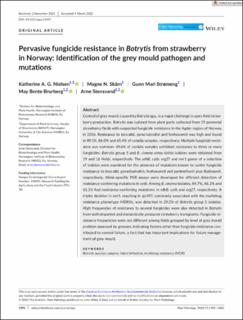| dc.contributor.author | Nielsen, Katherine Ann Gredvig | |
| dc.contributor.author | Skårn, Magne Nordang | |
| dc.contributor.author | Strømeng, Gunn | |
| dc.contributor.author | Brurberg, May Bente | |
| dc.contributor.author | Stensvand, Arne | |
| dc.date.accessioned | 2022-10-12T08:16:52Z | |
| dc.date.available | 2022-10-12T08:16:52Z | |
| dc.date.created | 2022-04-21T09:52:31Z | |
| dc.date.issued | 2022-03-15 | |
| dc.identifier.citation | Plant Pathology. 2022, 71 (6), 1392-1403. | en_US |
| dc.identifier.issn | 0032-0862 | |
| dc.identifier.uri | https://hdl.handle.net/11250/3025495 | |
| dc.description.abstract | Control of grey mould, caused by Botrytis spp., is a major challenge in open field strawberry production. Botrytis was isolated from plant parts collected from 19 perennial strawberry fields with suspected fungicide resistance in the Agder region of Norway in 2016. Resistance to boscalid, pyraclostrobin and fenhexamid was high and found in 89.1%, 86.0% and 65.4% of conidia samples, respectively. Multiple fungicide resistance was common; 69.6% of conidia samples exhibited resistance to three or more fungicides. Botrytis group S and B. cinerea sensu stricto isolates were obtained from 19 and 16 fields, respectively. The sdhB, cytb, erg27 and mrr1 genes of a selection of isolates were examined for the presence of mutations known to confer fungicide resistance to boscalid, pyraclostrobin, fenhexamid and pyrimethanil plus fludioxonil, respectively. Allele-specific PCR assays were developed for efficient detection of resistance-conferring mutations in cytb. Among B. cinerea isolates, 84.7%, 86.3% and 61.3% had resistance-conferring mutations in sdhB, cytb and erg27, respectively. A triplet deletion in mrr1, resulting in ΔL497, commonly associated with the multidrug resistance phenotype MDR1h, was detected in 29.2% of Botrytis group S isolates. High frequencies of resistance to several fungicides were also detected in Botrytis from both imported and domestically produced strawberry transplants. Fungicide resistance frequencies were not different among fields grouped by level of grey mould problem assessed by growers, indicating factors other than fungicide resistance contributed to control failure, a fact that has important implications for future management of grey mould. | en_US |
| dc.language.iso | eng | en_US |
| dc.publisher | John Wiley & Sons Ltd. on behalf of British Society for Plant Pathology | en_US |
| dc.rights | Attribution-NonCommercial-NoDerivatives 4.0 Internasjonal | * |
| dc.rights.uri | http://creativecommons.org/licenses/by-nc-nd/4.0/deed.no | * |
| dc.title | Pervasive fungicide resistance in Botrytis from strawberry in Norway: Identification of the grey mould pathogen and mutations | en_US |
| dc.title.alternative | Pervasive fungicide resistance in Botrytis from strawberry in Norway: Identification of the grey mould pathogen and mutations | en_US |
| dc.type | Peer reviewed | en_US |
| dc.type | Journal article | en_US |
| dc.description.version | publishedVersion | en_US |
| dc.rights.holder | © 2022 The Authors | en_US |
| dc.source.pagenumber | 1392-1403 | en_US |
| dc.source.volume | 71 | en_US |
| dc.source.journal | Plant Pathology | en_US |
| dc.source.issue | 6 | en_US |
| dc.identifier.doi | 10.1111/ppa.13557 | |
| dc.identifier.cristin | 2018082 | |
| dc.relation.project | Norges forskningsråd: 194051 | en_US |
| cristin.ispublished | true | |
| cristin.fulltext | original | |
| cristin.qualitycode | 2 | |

